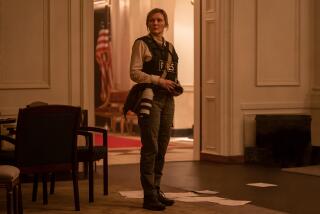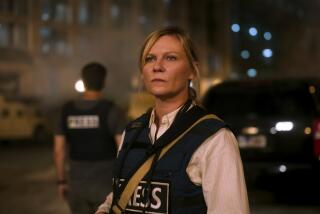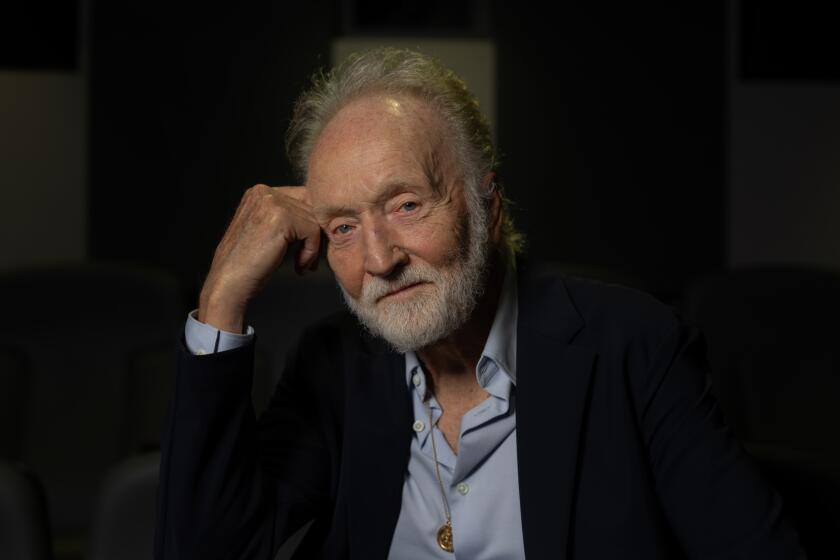‘Cloverfield’ has nothing to lose
The “Cloverfield” monster -- the giant rampaging creature that decapitates the Statue of Liberty and destroys much of Manhattan in the recent sci-fi hit -- has been favorably compared to Godzilla. While the picture’s box-office returns started big (an opening weekend of more than $40 million) and then seemed to stall, “Cloverfield’s” success is sufficient to have all involved thinking franchise. The creature is slated to return in a sequel from the movie’s original creative team: producer J.J. Abrams, writer Drew Goddard, and director Matt Reeves.
The Japanese “Godzilla” franchise, which eventually produced more than two dozen pictures, divested itself of its social consciousness right after its first giant-monster picture, a post-nuclear allegory, in 1954. And while there’s been much debate over the resemblances “Cloverfield’s” mayhem bears to that wreaked by the events of Sept. 11, it’s worth asking whether this movie actually has any social consciousness to divest. Depending on how you want to look at it, the makers of the film are either really good at doing their homework, or they’re just crass fear-mongers and tragedy-exploiters.
“Anyone who is upset about ‘Cloverfield’ must have had the same reaction to the recent ‘Spider-Man’ films or ‘I Am Legend’ or the ‘King Kong’ remake,” Abrams told Time magazine when asked whether the film’s destruction of New York hit too close to home.
On the one hand Abrams is absolutely correct -- Manhattan’s come in for a fair amount of cinematic damage since Sept. 11 (although in the case of the “King Kong” remake, it’s Manhattan of the 1930s). On the other hand, he’s being a bit disingenuous, since “Cloverfield” also happens to be the first sci-fi monster movie for which video footage of Sept. 11 could have served as a teaser trailer.
The original 1954 “Godzilla” explicitly and frequently referenced the nuclear attacks that preceded the rise of its fictional monster -- “Not after what I went through at Nagasaki,” one character replies after being asked if she’s going to stick around in the neighborhood Godzilla’s heading for in one scene -- and the movie ends on a pacifistic, don’t-trust-governments note.
“Cloverfield” depicts a competent and caring military (a little too caring, it would seem to some, as one of its soldiers ill-advisedly allows the movie’s main characters to leave their triage center) and otherwise shows no signs of any larger social consciousness, speculations on both ends of the political spectrum notwithstanding.
Chris Haire of the Charleston City Paper writes “some folks may deny that ‘Cloverfield’ is a commentary on 9/11, and frankly it’s those folks who we can thank for . . . ‘Garfield: A Tail of Two Kitties’ and the continued career of Uwe Boll.” All right, then. Let’s say we accept that “Cloverfield” is a “commentary” on Sept. 11; what exactly is it saying (other than that it was probably scary to be there, which is not likely news to anybody)?
Not much. Politics and the government aren’t referenced until very late in the film. When a tremor shakes the house party of the movie’s opening scenes, knocking out the lights for a bit, nobody mentions Sept. 11 or the New York City blackout of 2003 -- an event which, at the time, had almost everybody in the city wondering if they were experiencing “another” Sept. 11. One could almost surmise that “Cloverfield” takes place in a New York where Sept. 11 never happened, except, of course, for the absence of the Twin Towers in the skyline.
“Cloverfield’s” images of mobs fleeing enormous smoke clouds rolling down lower Manhattan’s streets and alleyways, its shots of hysterical, spectacularly disheveled citizens trying to make sense of what’s going on, all presented in the simulation of a home video, give this story of a few hapless twentysomethings fleeing from the rampage of a gigantic creature both an unsettling familiarity and a you-are-there-urgency. (“The Host,” Korean filmmaker Bong Joon-ho’s 2006 politically charged monster movie -- arguably the true heir to the “Godzilla” legacy -- managed to achieve the same sense of immediacy without the unsettling camera movement that has induced nausea in some “Cloverfield” audience members.)
But when a quasi-political idea enters the head of one of the characters near the film’s end, it’s one that only a Sept. 11 conspiracy nut might find useful. “I don’t read the papers,” luggish camera-wielding Hud muses. “Maybe our government made this thing.” This morsel of scintillating speculation is swept aside no sooner than it’s been dropped, which is not to say that “Cloverfield” is entirely without a credible whiff of apocalyptic paranoia.
The movie’s presentation as a “found object,” a bit of evidence now property of the U.S. government -- discovered, we are told, in the area “formerly known as Central Park” -- contributes to a sense of unease right off the bat. But all this boogity-boogity business is laid out more in the spirit of priming the viewer for scares than prompting actual thought.
For the conservative commentator (and Times columnist) Jonah Goldberg, writing in the National Review Online, “Cloverfield’s” significance comes to the fore when “the decapitated head of the Statue of Liberty comes screaming out of the sky. That’s hardly subtle symbolism for the end of America, or at least the end of America as we know it.”
Granted, the head of the Statue of Liberty may well be what they call a loaded symbol, but it’s also an image so iconic that a filmmaker who didn’t use it in this context would be, well, a bad filmmaker. And like so much of “Cloverfield,” it’s nothing the monster movie buff hasn’t seen before: Remember the shock ending of the original “Planet of the Apes”?
And yes, the decapitation in “Cloverfield” may well herald the end of America as it is known in the film. That is, the end of America at the claws and mouth of a rampaging monster. (Not to mention the parasites the creature sheds.) These critters have no rhyme or reason that we can tell, which makes their potential status as metaphors very dodgy indeed. Godzilla, we may recall, was awakened by nuclear explosions -- get it? The “Cloverfield” monster just pops up from out of nowhere. Which the terrorists responsible for Sept. 11 most assuredly did not.
More to Read
Only good movies
Get the Indie Focus newsletter, Mark Olsen's weekly guide to the world of cinema.
You may occasionally receive promotional content from the Los Angeles Times.










